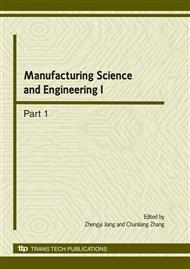p.71
p.75
p.81
p.85
p.90
p.96
p.100
p.107
p.111
Numerical Simulation of Push-Bending Process of Aluminum Section Profile
Abstract:
The aluminum profile can be formed into a complicated part such as 360º abnormity section circle parts that is difficult to be manufactured by other techniques. A new bending method was proposed for bending process. The push-bending principle, deformation procedure, curvature spring-back, section distortion and wrinkling are studied numerically. All cross-sections for the profile are provided a rather homogenous deformation degree. The curvature value of component and the distortion of section keep high consistence in push-bending process. The wrinkling tendency is reduced with increasing relative cross section thickness t/H and die radius R. The numerical model represents the observed response in the laboratory tests fairly well.
Info:
Periodical:
Pages:
90-95
Citation:
Online since:
March 2010
Authors:
Price:
Сopyright:
© 2010 Trans Tech Publications Ltd. All Rights Reserved
Share:
Citation:


